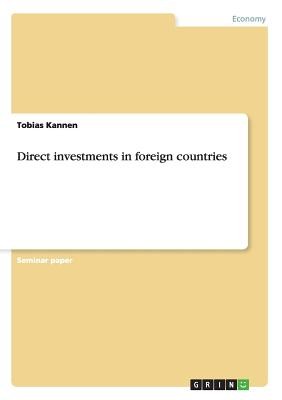
- We will send in 10–14 business days.
- Author: Tobias Kannen
- Publisher: GRIN Verlag
- Year: 2007
- Pages: 32
- ISBN-10: 3638648257
- ISBN-13: 9783638648257
- Format: 14.8 x 21 x 0.2 cm, softcover
- Language: English
- SAVE -10% with code: EXTRA
Reviews
Description
Seminar paper from the year 2004 in the subject Business economics - Investment and Finance, grade: 10 (Skala von 0 bis 10), University of Piraeus (Department of Business Administration), course: Seminar: Fundamentals of Management, language: English, abstract: In the 20th century, global competition and entering in foreign markets are not only opportunities for companies which want to improve their business position. As an example one study indentified 136 U.S. Industries - including automobiles, accounting services, entertainment, consumer electronics, and publishing - that will have to compete on a global basis or disappear. There are different ways in which to enter in a foreign market: Exporting, licensing, franchising, entering into a joint venture with a host country company, and setting up a wholly owned subsidary in the host country. This term paper will concentrate on the last two ways, which are called direct investments, which means that the company is involved in managing the productive assets, which distinguishes it from other entry strategies that permit less managerial control. It seems to be clear that, in general, competing in foreign markets where there are significiant cross-country variations in cultural, demographic, and market conditions, poses a much bigger strategy-making challenge than just competing at home. But where exactly are the main difficulties and how to solve at least the biggest problems? It sounds funny when we hear some mistakes of big companies like Wal-Mart, which has encountered difficulties in translating the warehouse club concept to Hong Kong. As a young accountant eyed a 4-pound jar of peanut butter, he said. "The price is right, but where should I put it?". Or when Coors Beer tried to translate a slogan with the phrase "Turn It Loose" into Spanish and it came out as "Drink Coors and Get Diarrhea". Although these examples may seem humorous, these kind of problems are serious for managers trying to operate in a compet
EXTRA 10 % discount with code: EXTRA
The promotion ends in 17d.02:58:40
The discount code is valid when purchasing from 10 €. Discounts do not stack.
- Author: Tobias Kannen
- Publisher: GRIN Verlag
- Year: 2007
- Pages: 32
- ISBN-10: 3638648257
- ISBN-13: 9783638648257
- Format: 14.8 x 21 x 0.2 cm, softcover
- Language: English English
Seminar paper from the year 2004 in the subject Business economics - Investment and Finance, grade: 10 (Skala von 0 bis 10), University of Piraeus (Department of Business Administration), course: Seminar: Fundamentals of Management, language: English, abstract: In the 20th century, global competition and entering in foreign markets are not only opportunities for companies which want to improve their business position. As an example one study indentified 136 U.S. Industries - including automobiles, accounting services, entertainment, consumer electronics, and publishing - that will have to compete on a global basis or disappear. There are different ways in which to enter in a foreign market: Exporting, licensing, franchising, entering into a joint venture with a host country company, and setting up a wholly owned subsidary in the host country. This term paper will concentrate on the last two ways, which are called direct investments, which means that the company is involved in managing the productive assets, which distinguishes it from other entry strategies that permit less managerial control. It seems to be clear that, in general, competing in foreign markets where there are significiant cross-country variations in cultural, demographic, and market conditions, poses a much bigger strategy-making challenge than just competing at home. But where exactly are the main difficulties and how to solve at least the biggest problems? It sounds funny when we hear some mistakes of big companies like Wal-Mart, which has encountered difficulties in translating the warehouse club concept to Hong Kong. As a young accountant eyed a 4-pound jar of peanut butter, he said. "The price is right, but where should I put it?". Or when Coors Beer tried to translate a slogan with the phrase "Turn It Loose" into Spanish and it came out as "Drink Coors and Get Diarrhea". Although these examples may seem humorous, these kind of problems are serious for managers trying to operate in a compet


Reviews